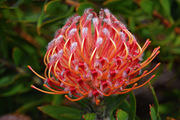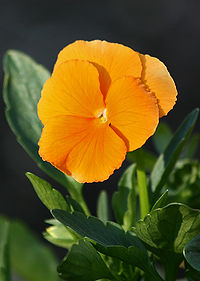Cultivar

a cultivar selected for its intriguing and colourful flowers
A cultivar is a cultivated variety of a plant that has been deliberately selected for specific desirable characteristics (such as the colour and form of the flower, yield of the crop, disease resistance, etc.). When propagated correctly, the plants of a particular cultivar retain their special characteristics.
The naming of cultivars is an important aspect of cultivated plant taxonomy, and the correct naming of a cultivar is prescribed by the Rules and Recommendations of the International Code of Nomenclature for Cultivated Plants (the ICNCP, commonly known as the Cultivated Plant Code). A cultivar is given a cultivar name, which is a Latin botanical name followed by a cultivar epithet, mostly in a vernacular language. For example, the full cultivar name of the King Edward potato is Solanum tuberosum 'King Edward'. The 'King Edward' part of the name is the cultivar epithet which, according to the Rules of the Cultivated Plant Code, is bounded by single quotation marks.[1]
Cultivars make up a major part of Liberty Hyde Bailey's broader grouping, the cultigen,[2] which is defined as a plant whose origin or selection is primarily due to intentional human activity.[3] The word cultivar was coined by Liberty Hyde Bailey and it is generally regarded as a portmanteau of "cultivated" and "variety", but could also be derived from "cultigen" and "variety".
A cultivar is not the same as a botanical variety,[4] and there are differences in the rules for the formation and use of the names of botanical varieties and cultivars. In recent times the naming of cultivars has been complicated by the use of statutary Plant Patents and Plant Breeders' Rights.[5]
Contents |
Origin of term
By scientific convention (the International Code of Botanical Nomenclature), the starting point for modern botanical nomenclature is taken to be those names that appeared in Linnaeus's publications Species Plantarum (edn 10) and Genera Plantarum (edn 5). In Species Plantarum, Linnaeus listed all the plants known to him, either directly or from his extensive reading. Linnaeus recognized the rank of varietas (in English this is the botanical "variety", a rank below that of species and subspecies) and he indicated these varieties by using letters of the Greek alphabet such as α, β, λ etc. (rather than the abbreviation var., which is the current convention). Most of Linnaeus's varieties were of “garden” origin rather than being wild plants.[6] Over time the need increased to distinguish between plants growing in the wild, and those with variations that had been produced in cultivation, a distinction that dates back to Theophrastus (370–285 BCE), the "Father of Botany" and head of the Peripatetic School of Philosophy at the Lyceum in Athens, who was keenly aware of this difference. Theophrastus, in his Enquiry into Plants, "had an inkling of the limits of culturally induced (phenotypic) changes and of the importance of genetic constitution" (Historia Plantarum III, 2,2 and Causa Plantarum I, 9,3).[7]
In the nineteenth century many of these "garden-derived" plants were given horticultural names, sometimes in Latin. From about the 1900s plants produced in cultivation in Europe were recognised in the Scandinavian, Germanic and Slavic literature through the words stamm or sorte[8] but these words could not be used internationally since, by international agreement, any new terms had to be based in Latin.[9] Eventually, in the twentieth century, an improved international terminology was proposed for the classification and nomenclature of cultivated plants.[10]
In 1923 the word cultivar was coined by Liberty Hyde Bailey of the Liberty Hyde Bailey Hortorium, Cornell University, New York State, when he wrote:
| “ | The cultigen is a species, or its equivalent, that has appeared under domestication – the plant is cultigenous. I now propose another name, cultivar, for a botanical variety, or for a race subordinate to species, that has originated under cultivation; it is not necessarily, however, referable to a recognized botanical species. It is essentially the equivalent of the botanical variety except in respect to its origin.[11] | ” |
In this paper Bailey used only the rank of species for the cultigen but it was clear to him that many domesticated plants were more like botanical varieties than species, and that appears to have motivated the suggestion of the new classification category cultivar, which is generally assumed to be a contraction of the words cultivated and variety. However, Bailey was never explicit about the etymology of the word cultivar and it has been suggested that it is a contraction of the words cultigen and variety, which seems more appropriate.[12]
The new word cultivar was promoted as ... euphonious. It is free from ambiguity. It serves a purpose.[13][nb 1] Its use was subsequently recommended by the first Cultivated Plant Code, which was published in 1953, and by 1960 it had achieved wide international acceptance.[14]
Cultigens and cultivars
The terms cultigen and cultivar may be confused with each other. Cultigen is a general-purpose term for plants that have been deliberately altered or specially selected by humans, while cultivar is a formal classification category. Cultigens include not only plants with cultivar names but also those with names in the classification categories of grex and Group. The Cultivated Plant Code points out that cultigens are: deliberately selected plants that may have arisen by intentional or accidental hybridization in cultivation, by selection from existing cultivated stocks, or from variants within wild populations that are maintained as recognizable entities solely by continued propagation.[15] Included within the group of plants known as cultigens are genetically modified plants, plants with binomial Latin names that are the result of ancient human selection, and any plants that have been altered by humans but which have not been given formal names.[16] Nevertheless, almost all cultigens are cultivars.[17]
Formal definition
The Cultivated Plant Code points out that the word cultivar is used in two different senses. As a classification category the cultivar is defined in Article 2 of the International Code of Nomenclature for Cultivated Plants (2009, 8th edition) as follows: The basic category of cultivated plants whose nomenclature is governed by this Code is the cultivar.[18] There are two other classification categories, the grex[19] and the Group.[20]
The Code then defines a cultivar in the sense of a taxonomic unit within the classification category of cultivar. This is the sense of cultivar that is most generally understood and which is used as a general definition.
| “ | A cultivar is an assemblage of plants that (a) has been selected for a particular character or combination of characters, (b) is distinct, uniform and stable in those characters, and (c) when propagated by appropriate means, retains those characters.[21] | ” |
Different kinds of cultivar
What constitutes a cultivar is driven by pragmatism, as the category was created to serve the practical needs of horticulture, agriculture and forestry.
Cultivars may arise by deliberate or accidental breeding, they may be variants selected from plants grown in cultivation, or they may be special selections from plants growing naturally in the wild.
Members of a particular cultivar are not necessarily genetically identical. The Cultivated Plant Code emphasizes that different cultivated plants may be accepted as different cultivars, even if they have the same genome, while cultivated plants with different genomes may be regarded as the same cultivar. The production of cultivars generally entails considerable human involvement although in a few cases it may be as little as simply selecting variation from plants growing in the wild (whether by collecting growing tissue to propagate from or by gathering seed).[22]
Cultivars generally occur as garden and food crops: 'Granny Smith' and 'Red Delicious' are cultivars of apples propagated by cuttings or grafting, 'Red Sails' and 'Great Lakes' are lettuce cultivars propagated by seeds. Named cultivars of Hosta and Hemerocallis plants are cultivars produced by micropropagation or division.
Clones

a cross performed in Tasmania between L. glabrum and L. tottum
Cultivars that are produced asexually are genetically identical and known as clones. Included here are plants propagated by division, cuttings, grafts, and budding. The propagating material may be taken from a particular part of the plant, for example a lateral branch, or from a particular phase of the life cycle, say a juvenile leaf, or from aberrant growth as occurs with witches brooms. Plants whose distinctive characters are derived from the presence of an intracellular organism may also form a cultivar provided the characters are reproduced reliably from generation to generation. Plants of the same chimaera (which have mutant tissues close to normal tissue) or graft-chimaeras (which have vegetative tissue from different kinds of plants and which originate by grafting) may also form a cultivar.[23]
Seed-produced
Seed-raised cultivars can be produced by uncontrolled pollination provided the cultivar can be distinguished by one or more characters that are distinct, uniform and stable under propagation. They may be produced as “lines” that are produced by repeated self-fertilization or inbreeding or “multilines” that are made up of several closely related lines. Sometimes they are F1 hybrids which are the result of a deliberate repeatable single cross between two pure lines. There are a few F2 hybrid seed cultivars too (such as Achillea 'Summer Berries').
Cultivars may also arise as a result of a change in ploidy level of a plant and agamospermous plants that retain their genetic composition and characteristics under reproduction may form cultivars.[24] Occasionally cultivars are raised from seed of a specially selected provenance – for example the seed may be taken from plants that are disease resistant.[25]
Genetically modified
Genetically modified plants with characters resulting from the deliberate implantation of genetic material from a different germplasm may form a cultivar.[26]
Cultivar names
Cultivars are identified by uniquely distinguishing names. Names of cultivars are regulated by the International Code of Nomenclature for Cultivated Plants, are registered with an International Cultivar Registration Authority (ICRA) and conform to the rules of the ISHS International Society for Horticultural Science (ISIS) Commission for Nomenclature and Cultivar Registration. There are separate registration authorities for different plant-groups. In addition, cultivars may get a trademark name, protected by law (see Trade designations and "selling names", below).
Presenting in text

The specific epithet may be omitted from a cultivar name
A cultivar name consists of a botanical name (of a genus, species, infraspecific taxon, interspecific hybrid or intergeneric hybrid) followed by a cultivar epithet. The cultivar epithet is capitalised and put between single quotes: preferably it should not be italicized.[27] Cultivar epithets published before 1 January 1959 were often given a Latin form and can be readily confused with the specific epithets in botanical names: after that date, newly coined cultivar epithets must be in a modern vernacular language to distinguish them from botanical epithets.[28]
- Cryptomeria japonica 'Elegans'
- Chamaecyparis lawsoniana 'Aureomarginata' (pre-1959 name, Latin in form)
- Chamaecyparis lawsoniana 'Golden Wonder' (post-1959 name, English language)
- Pinus densiflora 'Akebono' (post-1959 name, Japanese language)
- Some incorrect examples:
- Cryptomeria japonica "Elegans" (double quotes are unacceptable)
- Berberis thunbergii cv. 'Crimson Pygmy' (this once-common usage is now unacceptable, as it is no longer correct to use "cv." in this context; Berberis thunbergii 'Crimson Pygmy' is correct)
- Rosa cv. 'Peace' (this is now incorrect for two reasons: firstly, the use of "cv."; secondly, "Peace" is a trade designation or "selling name" for the cultivar R. 'Madame A. Meilland' and should therefore be printed in a different typeface from the rest of the name, without any quote marks, for example: Rosa Peace.)
Group names
Where several very similar cultivars exist, these are termed Groups; the name is in normal type and capitalised as in a single cultivar, but not in single quotes, and followed by "Group" (or its equivalent in other languages).[29]
Presenting in text
- Brassica oleracea Capitata Group (the group of cultivars including all typical cabbages)
- Brassica oleracea Botrytis Group (the group of cultivars including all typical cauliflowers)
- Hydrangea macrophylla Groupe Hortensis (in French) = Hydrangea macrophylla Hortensia Group (in English)
Where cited with a cultivar name the Group should be enclosed in parentheses, as follows:
- Hydrangea macrophylla (Hortensia Group) 'Ayesha' [30]
Some cultivars and cultivar Groups are so well "fixed" or established that they "come true from seed", meaning that the plants from a seed sowing (rather than vegetatively propagated) will show very little variation. In the past, such plants were often called by the terms "variety", "selection" or "strain"; these terms (particularly "variety", which has a very different botanical meaning) are best avoided with cultivated plants. Normally, however, plants grown from seed taken from a cultivar can be very variable and such seeds or seedling plants should never be labelled with, or sold under, the parent cultivar's name (see [2] an article by Tony Lord of The RHS Plant Finder).
International Cultivar Registration Authorities
An International Cultivar Registration Authority (ICRA) is a voluntary, non-statutory organization appointed by the ISHS’s Commission for Nomenclature and Cultivar Registration. The members of the system come mostly from societies and institutions specializing in particular plant genera such as Dahlia or Rhododendron and are currently located in Europe, North America, China, India, Singapore, Australia, New Zealand, South Africa and Puerto Rico.[31]
Annual reports are produced by each ICRA and reappointment is considered every four years. Each ICRA maintains the names for the cultivars in its interest group registers of the names within th group are maintained and published periodically. One major aim is to prevent duplicated uses of cultivar and Group epithets within a genus, as well as ensuring that names are in accord with the latest edition of the Cultivated Plant Code. This is a way of regulating cultivated plant nomenclature; over the 50 years or so that ICRAs have existed they have contributed significantly to the stability and fixity of cultivated plant nomenclature. In recent times many ICRAs have also recorded trade designations and trademarks used in labelling plant material, to avoid confusion with established names.
New names and other relevant data are collected by and submitted to the ICRA and in most cases there is no cost. The ICRA then checks each new epithet to ensure that it has not been used before and that it is in accord with the Cultivated Plant Code. Each ICRA also ensures that new names are formally established (i.e. published in hard copy, with a description in a dated publication). They also record details about the plant, such as parentage, the names of those concerned with its development and introduction, together with a basic description highlighting its distinctive characters. ICRAs are not responsible for assessing the distinctiveness of the plant in question.
Most ICRAs can be contacted electronically and many maintain excellent web sites: for an up-to-date listing see here.
Trade designations and "selling names"
Cultivars that are still being developed and not yet ready for release to retail sale are often coded with letters and/or numbers before being assigned a name. It is common for this code name to be quoted alongside the new cultivar name or trade designation when the plant is made available commercially (for example Rosa Fascination = 'Poulmax') and this may continue, in books or magazines and on plant labels, for several years after the plant was released. Because a name that is attractive in one language may have less appeal in another country, a plant may be given different selling names from country to country. Quoting the original code name allows the correct identification of cultivars around the world and helps to avoid the once-common situation where the same plant might, confusingly, be sold under several different names in one country, having been imported under different aliases.
Another form of what the Cultivated Plant Code (ICNCP) calls a trade designation is the plant "variety", as defined in the UPOV Convention (not to be confused with the botanical rank of variety).
Legal protection
Cultivars are not legally protected, as such. The status as cultivar deals only with the name it should be given (under the ICNCP), and has no legal dimension. However, a cultivar is not prevented from being legally protected; in as far as it is possible to legally protect particular kinds of plants, this can be done whether they also enjoy recognition as a cultivar or not.
Legal protection may help to encourage the development of new useful cultivars; "protected cultivars" are the result of deliberate breeding programs and selection activity by nurseries and plant breeders, and are often the result of years of work.[32] "Plant patents" and "plant breeder's rights" (which can be expensive to obtain) are means for the breeder or inventor to obtain financial reward for their work.[33]
With plants produced by genetic engineering becoming more widely used, the companies producing these plants (or plants produced by traditional means) often claim a patent on their product. Plants so controlled retain certain rights that accrue not to the grower, but to the firm or agency that engineered the variety.
Such plants are often labeled "PBR", which stands for "plant breeders' rights", or "PVR", which stands for "plant variety rights." It is illegal in countries that obey international law to harvest seeds from a patented "variety" or cultivar except for personal use. Other means of legal protection include the use of trade marked names whereby the name the plant is sold under is trademarked, but the plant itself is not protected. Trademarking a name is inexpensive and fairly simple, while patents can take a few years to be granted and be more expensive. Some previously named cultivars have been renamed and sold under trademarked names.
In horticulture, plants that are patented or trademarked are often licensed to large wholesalers who multiply and distribute the plants to retailers. The wholesalers pay a fee to the patent or trademark holders for each plant sold; the patented plants are labeled with "It is unlawful to propagate this plant" or a similar phrase. Typically the license agreement specifies that a plant must be sold with a tag marked in this way to help ensure that no illegally produced plants are sold.
The use of plant patents (particularly for food crops that are staples in developing countries[34], or for plants selected from the wild and propagated for sale without any additional breeding work) is considered unethical by some people.[35]
Propagation of cultivars in gardens

Some cultivars sexually reproduce within the garden and the distinct cultivar characters disappear, especially those that originated from hybridization, the resulting offspring are no longer the same cultivar.[36]
Cultivars that are propagated by asexual means (such as division, cuttings or micropropagation) generally do not "come true" from seed. Plants raised from seed saved from these plants should never be called by the cultivar name.
Seeds collected from seed-raised cultivars may or may not "come true" when sown. Cross-pollination with other plants in the garden or from the surrounding area could occur that could contaminate the seed line and produce different plants in the next generation. Even if a seed-raised cultivar is grown in isolation, its seedlings can alter as different combinations of recessive genes are expressed, so good breeders maintain the seed lines by weeding out atypical plants before they can pass on their genes (or pathogens) to the next generation and affect the cultivar line.[37] Nevertheless, each new generation may still differ imperceptibly in their flower colour, habit or other characteristics from the previous one, resulting in a gradual drift away from the original cultivar. It may therefore be necessary to re-select the best seedlings in order to get back, as nearly as possible, to the original cultivar: these selections are often listed by seed suppliers as "Improved" (e.g. Myosotis sylvatica 'Royal Blue Improved', Lobelia 'Mrs Clibran Improved'). [38]
See also
- Variety (plant)
Notes
- ↑ Cultivated Plant Code Article 14.1 Brickell 2009, p. 19
- ↑ Bailey 1923, p. 113
- ↑ Spencer & Cross 2007, p. 938
- ↑ Lawrence 1953, p. 19–20
- ↑ See [1] Retrieved: 2010-1-7.
- ↑ Lawrence 1955, p. 177
- ↑ Morton 1981, p. 38–39
- ↑ Lawrence 1955, p. 180
- ↑ Lawrence 1955, p. 181
- ↑ Lawrence 1955, p. 179–180
- ↑ Bailey 1923, p. 113
- ↑ Trehane 2004, p. 17
- ↑ Lawrence 1955, p. 180
- ↑ Lawrence 1960, p. 1
- ↑ Cultivated Plant Code Art. 2.3 Brickell 2009, p. 1
- ↑ Spencer, Cross & Lumley 2007, p. 47
- ↑ Spencer, Cross & Lumley 2007, p. 53
- ↑ Cultivated Plant Code. Art. 2.1 Brickell 2009, p. 6
- ↑ Cultivated Plant Code. Art. 4 Brickell 2009, p. 12
- ↑ Cultivated Plant Code. Art. 3 Brickell 2009, pp. 10–12
- ↑ Cultivated Plant Code. Art. 2.3 Brickell 2009, p. 6
- ↑ Cultivated Plant Code, Article 2.20 Brickell 2009, p. 9
- ↑ Cultivated Plant Code, Articles 2.5–2.11 Brickell 2009, pp. 6–7
- ↑ Cultivated Plant Code, Articles 2.17–2.18 Brickell 2009, pp. 7–8
- ↑ Cultivated Plant Code, Articles 2.12–2.16 Brickell 2009, pp. 7–8
- ↑ Cultivated Plant Code, Articles 2.19 Brickell 2009, pp. 8–9
- ↑ Lawrence 1957, pp. 162–165
- ↑ Cultivated Plant Code Art. 14 Brickell 2009, p. 19
- ↑ Cultivated Plant Code Art. 3 Brickell 2009, pp. 10–12
- ↑ Cultivated Plant Code Art. 15 Brickell 2009, p. 19
- ↑ Cultivated Plant Code Brickell 2009, pp. 62, 67–83
- ↑ BSPB Plant breeding - The business and science of crop improvement British Society of Plant Breeders booklet
- ↑ P. Gepts (2004) Who Owns Biodiversity, and How Should the Owners Be Compensated? Plant Physiology 134, 1295-1307
- ↑ Adi, A.B.C., Intellectual Property Rights in Biotechnology and the Fate of Poor Farmers' Agriculture. Social Science Research Network accessed 5 January 2010
- ↑ 'Who owns nature?' (article by nurseryman and plant hunter Michael Wickenden, published in The Plantsman)
- ↑ http://www.ext.colostate.edu/Pubs/Garden/07602.html
- ↑ Oregonstate.edu
- ↑ Jellito.com (>Breeding)Commercial seed company's website, accessed 5 January 2010
Footnotes
- ↑ This ignored its prior existence as a transitive verb in Spanish, meaning to farm, to cultivate, to grow, or to practice. Online Spanish dictionary Retrieved 2010-8-6, and in Portuguese meaning to cultivate, to husband, to farm, to plant, to polish, to reclaim, to improve. Ectaco online Portuguese dictionary Retrieved 2010-8-6.
References
- Bailey, Liberty Hyde (1923). "Various cultigens, and transfers in nomenclature". Gentes Herbarum 1: 113–136.
- Brickell, Chris D. et al. (eds) (2009). "International Code of Nomenclature for Cultivated Plants (ICNCP or Cultivated Plant Code) incorporating the Rules and Recommendations for naming plants in cultivation. 8th edn, adopted by the International Union of Biological Sciences International Commission for the Nomenclature of Cultivated Plants". Scripta Horticulturae (International Society of Horticultural Science) 10: 1–184. ISBN 9780643094406.
- Lawrence, George H.M. (1953). "Cultivar, Distinguished from Variety". Baileya 1: 19–20.
- Lawrence, George H.M. (1955). "The Term and Category of Cultivar". Baileya 3: 177–181.
- Lawrence, George H.M. (1957). "The Designation of Cultivar-names". Baileya 5: 162–165.
- Lawrence, George H.M. (1960). "Notes on Cultivar Names". Baileya 8: 1–4.
- Morton, Alan G. (1981). History of Botanical Science: An Account of the Development of Botany from Ancient Times to the Present Day. London: Academic Press. ISBN 0125083823.
- Spencer, Roger; Cross, Robert; Lumley, Peter (2007). Plant names: a guide to botanical nomenclature. (3rd edn). Collingwood, Australia: CSIRO Publishing (also Earthscan, UK.). ISBN 9780643094406..
- Spencer, Roger D.; Cross, Robert G. (2007). "The Cultigen". Taxon 56(3): 938.
- Trehane, Piers (2004). "50 years of the International Code of Nomenclature for Cultivated Plants". Acta Horticulturae 634: 17–27.
External links
- Sale point of the Latest Edition (February 2004) of The International Code of Nomenclature for Cultivated Plants
- International Cultivar Registration Authorities
- The Language of Horticulture
- Opinion piece by Tony Lord (from The Plantsman magazine)
- Hortivar - The Food and Agriculture Organization of the United Nations Horticulture Cultivars Performance Database